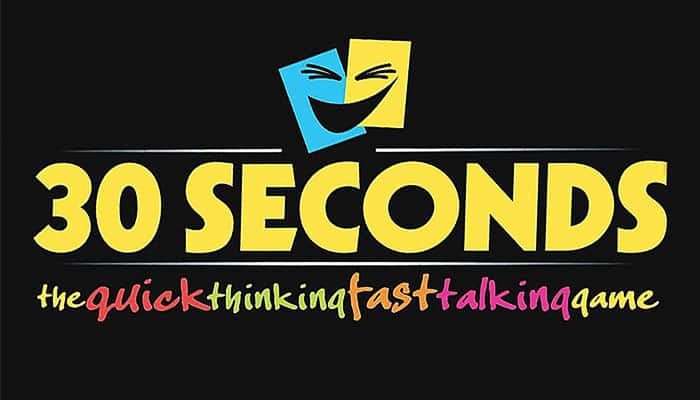
30 SECONDS is a description game played by two or more teams. The more players per team the better.
For example: if six people want to play, two teams of three players are better than three teams of two. As few as three people can play 30 Seconds.

Components
- 240 cards (2 400 names)
- 1 game board
- 1 thirty-second timer
- 1 die
- 4 playing tokens
- 1 rules leaflet
Object of the Game
To be the first team to reach the FINISH square. Teams advance by correctly identifying the names that their team-mates are describing.
Teams must strive to identify as many names as possible during each turn of 30 seconds - the most being five.
Describing and Identifying
Players are called describers and identifiers. All players must take their turn at being both describers and identifiers. The describer within a team must rotate with each turn.
Describers May
- describe the names in any way they wish, including singing, humming and gesticulating;
- describe the names in any order;
- use the words 'and' and 'the' that appear in some of the names.
Describers May Not
- say the actual names on the card in their hand;- look at the names that must be described before the timer is turned over;
- say any names or words derived from or related to the names they're describing;
- use any 'sounds-like' or 'rhymes-with' tactics;- say or refer to the letters of the alphabet;
- use translations;
- point to anything.
Identifiers MAY use the letters of the alphabet.
Setup
The players divide into teams. Each team selects a token and places it on the START square. All the teams roll the die. The team that rolls the highest number will start the game.
If two or more teams tie with the highest number, they roll again. Each team decides the order in which its members will play. This order must be maintained throughout the game.

Game Play
The role of the die:
The die is numbered 0,0,1,1,2,2.The die must be rolled at the start of a team's turn before a card is taken out of the card box.
At the end of a team's turn the number that was rolled is subtracted from the number of names the team correctly identified during that turn. The team then advances their token that number of squares.
For Example:
if a team rolled 2 at the start of their turn and correctly identified four names during that turn, they move two squares forward.
if a team rolled 0 and correctly identified three names, they move three squares forward.
If a team correctly identified the same number of names or fewer names than the number rolled, they remain on the same square. The team with the first turn rolls the die.
The starting describer must take a card from the 'OUT' side of the card box. Each card has a blue and yellow side. The color square that a team's token is on at the start of their turn, determines which side of the card is used.

If a team's token is on a yellow square, the names on the yellow side of the card must be described, and likewise for blue. (As the START square is blue, all the teams must first describe the names on the blue side of the card).
On each side of the card, there are five names, which may be described in any order.

The describer MAY NOT look at the names that must be described BEFORE the timer is turned over. The player that turns the timer over must say 'GO' as the timer is turned. The describer may turn the card and start describing once 'GO' is called out.
The identifiers shout out their guesses while the describer is describing. It is the responsibility of the other teams to keep an eye on the timer and to call' TIME UP' when the timer runs out.
The number that was rolled at the start of the turn is subtracted from the number of names correctly identified, and the token is moved accordingly. The card must be put back into the 'IN' side of the cardbox. The die is passed to the left.

End of the Game
The first team to reach the FINISH square is the winner.
How Strict?
At the start of the game, the teams must make a ruling about the preciseness of the answer s. For example: is Mickey acceptable for Mickey Mouse?
The teams also have to decide if the full name must be given before the timer runs out.
For example: is it acceptable if the identifier says Mickey before 'TIME UP' is called, and Mouse afterwards.
? Penalties
When a player violates any of the rules that team ' s turn ends immediately and their token is moved back one square.
Rules for Three Players
If three people wish to play, one player must act as the describer for both teams, for the duration of the game. Otherwise, the game rules are the same.
Continue Reading

